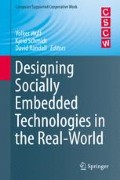Abstract
The design of IT artifacts has been focused for the past 50 years on delivering products that serve the needs of a particular set of end users. User-centered design methods relating to the design of IT artifacts have evolved in both the academic context, in fields such as HCI, and in the commercial context. Both share a common commitment to the analysis and understanding of stakeholder requirements. The underlying rationale of such methods was that there exists a “perfect” design solution for supporting a given set of use cases and that the shipped design should reflect this as much as possible to guarantee product success.
Access this chapter
Tax calculation will be finalised at checkout
Purchases are for personal use only
References
Beyer, H., & Holtzblatt, K. (1998). Contextual design: Defining customer-centered systems. San Francisco: Morgan Kaufmann Publishers. ISBN 1558604111.
Dörner, C., Draxler, S., Pipek, V., & Wulf, V. (2009). End users at the bazaar: Designing next-generation enterprise resource planning systems. IEEE Software, 26(5), 45–51.
Dubberly, H. (2002, September + October 2008). ON MODELING. Design in the age of biology: Shifting from a mechanical-object ethos to an organic-systems ethos. Interactions, 15(5). doi:10.1145/1390085.1390092.
Fischer, G., & Giaccardi, E. (2006). Meta-design: A framework for the future of end-user development. In H. Lieberman, F. Paternò, & V. Wulf (Eds.), End user development: Empowering people to flexibly employ advanced information and communication technology (pp. 421–452). Dordrecht: Kluwer Academic Publisher.
Fischer, G., Giaccardi, E., Ye, Y., Sutcliffe, A. G., & Mehandjiev, N. (2004). Meta-design: A manifesto for end-user development. Communications of the ACM, 47 (9, September), 33–37. doi:10.1145/1015864.1015884.
Holtzblatt, K. (2011). What makes things cool?: Intentional design for innovation. Interactions, 18(6, November), 40–47. doi:10.1145/2029976.2029988.
Latzina, M., & Beringer, J. (2012). Transformative user experience: Beyond packaged design. Interactions, 19(2, March), 30–33. doi:10.1145/2090150.2090159.
Lieberman, H., Paterno, F., & Wulf, V. (Eds.). (2006). End user development. Dordrecht: Kluwer Publishers.
Michael Weiksner, G., Fogg, B. J., & Xingxin Liu (2008, June 4–6). Six patterns for persuasion in online social networks. Proceedings of the 3rd international conference on persuasive technology, Oulu, Finland. doi:10.1007/978-3-540-68504-3_14.
Sanders, L. (2008). ON MODELING: An evolving map of design practice and design research. Interactions, 15(6, November), 13–17. doi:10.1145/1409040.1409043, http://doi.acm.org/10.1145/1409040.1409043
Schrage, M. (2005, May). Automation, augmentation and innovation: Redefining the future of delegation in the new world of work. Cambridge, MA: MIT White Paper.
Taylor, J. C. (1998). Participative design: Linking BPR and SAP with an STS approach, Journal of Organizational Change Management, 11(3), 233–245. doi:10.1108/09534819810216265.
Wulf, V., & Rohde, M. (1995). Towards an integrated organization and technology development. In G. Olson, & S. Schuon (Eds.), Symposium on designing interactive systems (Processes, practices, methods & techniques) (pp. 55–65). New York: ACM Press.
Wulf, V., Rohde, M., Pipek, V., & Stevens, G. (2011). Engaging with practices: Design case studies as a research framework in CSCW. In Proceedings of the ACM 2011 conference on Computer Supported Cooperative Work (CSCW’11) (pp. 505–512). New York: ACM Press.
Author information
Authors and Affiliations
Corresponding author
Editor information
Editors and Affiliations
Rights and permissions
Copyright information
© 2015 Springer-Verlag London
About this chapter
Cite this chapter
Beringer, J., Latzina, M. (2015). Socially Embedded Technology: The Pathway to Sustainable Product Development. In: Wulf, V., Schmidt, K., Randall, D. (eds) Designing Socially Embedded Technologies in the Real-World. Computer Supported Cooperative Work. Springer, London. https://doi.org/10.1007/978-1-4471-6720-4_2
Download citation
DOI: https://doi.org/10.1007/978-1-4471-6720-4_2
Publisher Name: Springer, London
Print ISBN: 978-1-4471-6719-8
Online ISBN: 978-1-4471-6720-4
eBook Packages: Computer ScienceComputer Science (R0)

